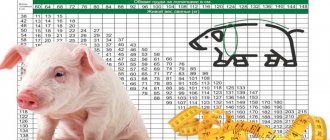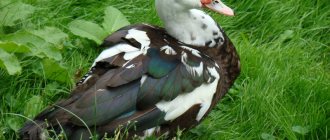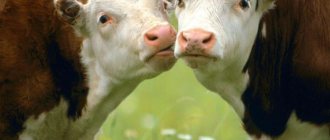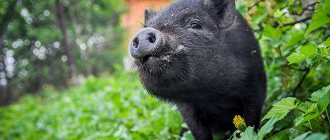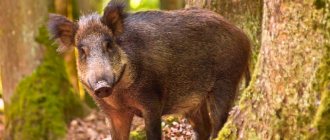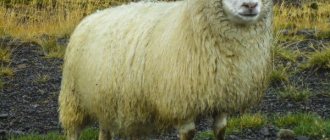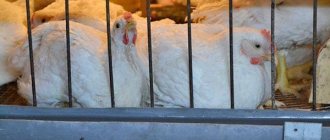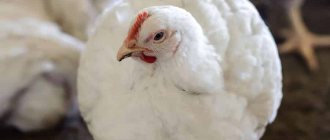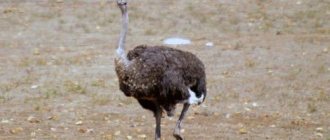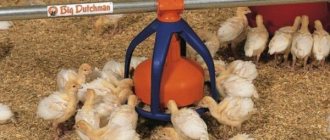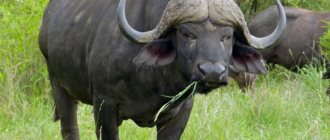Average weight of an animal at slaughter
The weight of a grown animal is directly dependent on the selected variety and proper diet. One of the heaviest animals is the large white breed. For example, the weight of sows reaches 320-340 kg. They are not inferior to wild boars, giving figures of 320-350 kg. The normal average weight of a pig is 210-260 kg.
Increasing the weight of a piglet most of all depends on the organization of competent feeding. On average, at 3-4 months, representatives of any breed reach 55-65 kg, and if fed ad libitum, the animal will reach 100 kg at 3 months.
The weight of Vietnamese pot-bellied pigs can be 150 kg. But usually they are slaughtered early at 6-7 months, weighing 70-80 kg.
It is not difficult to determine how much a pig weighs on average. You can use scales or other methods that we talked about in the article “Measuring the weight of a pig using a table.”
Why is such information needed?
In order for pigs to successfully gain weight, they constantly require a certain amount of feed.
To calculate the required volumes, it is advisable to know the weight of pigs that are fattened for a specific purpose. Based on the weight gain of even one pig out of the entire farrowing, the farmer is able to draw an objective picture of his work and either leave everything as is, or make some adjustments. There are other needs for such knowledge. For example:
- the introduction of additional feed or fortified supplements requires precise control over weight gain - you cannot give too little, otherwise there will be no effect, but overfeeding is also not good - costs increase;
- if the pig is already “ripe” to be sold for meat, the cattle breeder would probably need some kind of “insurance” - the ability to estimate the weight of the pig at home without scales in order to assess future benefits;
- When an animal gets sick, it sometimes has to be given medicine. In such cases, the required dose must be calculated based on live weight.
Of course, these methods cannot compete with measurements on precise scales, but they allow you to approximately estimate the weight of a pig on average, and this is often quite enough.
Pork meat yield from live weight
Above we talked about live weight; slaughter weight is a different concept. This refers to the yield of a pure product after cutting the animal. These indicators do not include internal organs, skin and legs (lower part). Accordingly, the figure is always smaller. Let's take a closer look at this and other concepts.
Pigs are one of the most profitable animals in terms of obtaining a meat product. When cutting a pig, the least amount of waste is produced. So, slaughter weight means a carcass with the skin removed, the head, lower parts of the limbs, and internal organs removed.
Boning involves separating bones from muscle tissue. The slaughter yield is considered to be the percentage of the mass obtained after slaughter of the carcass to the live one.
After slaughtering an animal weighing 100 kg, clean meat comes out from 63 to 72 kg. At the same time, lard accounts for 14-24 kg. The deboning yield rates show that the amount of product in percentage terms is 63-72%. All these are average statistical indicators.
If the pig moves a lot, then the sebaceous layer will be small, and if the animal has a passive lifestyle, there will be less pure pork - all the nutrition is used to accumulate fat.
How much meat and other products, as a percentage, will be obtained when slaughtering an individual weighing 100 kg is shown in the table of meat (pork) yield based on live weight:
Keep in mind that the table shows average data. Figures may vary depending on the breed of pigs, their age, and individual characteristics.
Primary processing of slaughter animals
The slaughter yield of horses of local breeds with the highest fatness reaches 60%, with average fatness – 48–52% and below average – 45–48%.
In young horses, the relative content of muscle tissue in the carcass is greater than in older horses, in which fat deposition increases during fattening.
The weight of skin at the slaughter of adult animals ranges from 5 to 6.5% of their live weight.
The highest daily gains (0.6 - 1 kg) in young animals are observed in spring and summer in the first and second years of life, after which they decrease. It is economically feasible to sell young animals for meat at the age of 1 ½ - 2 ½ years, when the best quality products are obtained. Crossing local horses with producers of heavy draft breeds makes it possible to obtain young animals that quickly reach slaughter conditions with good meat qualities.
Bird.
One of the critical operations in the technological process of meat production is poultry slaughter, carried out in the slaughterhouses of the relevant farms or in poultry and meat-and-poultry plants on mechanized production lines. At the same time, batches of similar-aged, well-fed birds of approximately the same weight are killed. Poultry of all species are kept without food for several hours before slaughter to allow the gastrointestinal tract to empty itself of its contents.
There are mainly two common methods of slaughtering poultry. With the internal method of slaughter, the junction of the jugular and pontine veins is cut with scissors through the oral cavity of the bird; an injection is made into the anterior lobe of the cerebellum; for external - cut the skin, jugular vein and carotid artery at a distance of 1 cm from the angle of the lower jaw. The quality of the product and the duration of its storage depend on the proper organization of poultry slaughter.
The yield of poultry meat is determined by the ratio of the weight of meat to the pre-slaughter weight of the bird as a percentage. The yield of meat in cooled form for semi-gutted chicken carcasses is 80.5%, broiler chickens - 81.8%, ducklings - 80.4%, ducks - 80.6%, turkeys - 81.7%, geese - 79.2 %. Poultry meat immediately after slaughter at a temperature in the muscle thickness above +25°C is called steamed, at a temperature from 0 to +4° - chilled, and at a temperature not higher than -8°C - ice cream.
Cattle.
Indicators of meat productivity of animals are: live weight, slaughter yield, the ratio of individual high-quality cuts in the carcass, the composition of meat and its nutritional value.
Live weight is the weight of the animal.
Slaughter weight is the weight of the carcass and internal raw fat. In the meat processing industry, this is the mass of a fresh meat carcass without raw fat.
Slaughter yield is the ratio of slaughter weight to pre-slaughter live weight, expressed as a percentage. In the meat processing industry, the ratio of fresh carcass weight to live weight with a discount for the contents of the gastrointestinal tract.
Meat (beef) is the carcass of a killed animal without skin, head, entrails, internal fat and limbs (front - up to the carpal joint, rear - along the hocks).
Table No. 3.
Dependence of meat productivity of young cattle on live weight.
| Indicators | Animal class by live weight, kg | ||||
| 200-300 | 301-350 | 351-400 | 401-450 | over 450 | |
| Number of animals, heads. | 165 | 199 | 259 | 283 | |
| Average live weight, kg | 277,3 | 326,8 | 378,9 | 423,7 | |
| Carcass weight, kg | 142,2 | 167,2 | 200,1 | 277,1 | 269,5 |
| Slaughter yield of carcass, % | 51,2 | 51,2 | 52,8 | 53,6 | 54,3 |
| Internal fat mass, kg | 7,7 | 8,7 | 12,8 | 14,1 | 18,7 |
| Bone content in carcass, kg | 20,4 | 19,7 | 19,3 | 18.6 | 17,4 |
| Pulp yield per 1 kg of bones, kg | 3,9 | 4,1 | 4,2 | 4,4 | 4,8 |
| Content of protein and fat in the carcass, kg | 31,7 | 37,6 | 47,3 | 58,1 | 70,7 |
| Including: squirrel | 22,3 | 26,8 | 31,6 | 36,5 | 42,9 |
| fat | 9,4 | 10,8 | 15,4 | 21,6 | 27,8 |
Weight of carcass, half carcass and various parts of the animal
The live weight of an animal is the weight before slaughter. After slaughter, cutting and processing, it is divided into parts. Most often, a pig carcass weighing 110 kg has 74 kg of meat product, 22 kg of lard, as well as 11 kg of bones and about 3 kg of various waste.
The weight of a half carcass after removing the bones and fat is on average 35-40 kg. In a meat breed pig, the amount of bacon will be 13%, and in an individual with a high fat content factor - 25%. About 12% of the total weight of the side carcass is on the bone. Losses during cutting are approximately 1%.
Regardless of the breed of young animals, the yield of pork in comparison with the amount of fat obtained is greater than that of adult animals that are fattened.
The head of an animal weighing 120 kg weighs about 10 kg, and the hind leg weighs about 8-9 kg. The average weight of a month-old pig is 7-9 kg. At 5 months it reaches 85-90 kg. The yield of pure meat from this individual is within 40 kg without bones and offal.
Pork categories
Pork after slaughter is used as a table product and for the production of sausages, canned food and various smoked products. The selection of products is carried out according to the category of meat, which, depending on the heat treatment used, can be cooled, chilled or frozen.
Unlike beef, pork is dense, soft and tender meat, which at different ages of individuals has a different color - from light pink (in young ones) to red (in more mature ones).
The classification of pork depends on the degree of fatness of the animal. The resulting product is divided into:
The first category refers to dairy piglets one month old with a carcass weight of 5 to 9 kilograms. Others talk about the purpose of raising animals.
Ripening of pork meat after slaughter
After the slaughter of an individual, various processes occur in the meat that determine its quality properties. A distinction is made between rigor rigor and softening (ripening of meat).
After several days in the refrigerator at a temperature of 5-10 degrees above zero, the pork will become flavorful. The product acquires excellent taste characteristics, juice comes out of it - an indicator that the meat is ripening.
A characteristic feature is the appearance of a “dry crust” on the carcass, elasticity and a specific smell. To determine the degree of ripening of pork, histological and chemical studies are used.
Long-term storage of this product without freezing leads to a change in its consistency, color, release of watery juice and the appearance of a musty odor. As a result, putrefactive microflora develops, and the pork begins to deteriorate instantly.
Pig meat output
The size of the slaughter yield is influenced by many reasons. Some of the most important factors are the animal’s physique and the meat properties of the breed being raised. Compact pigs often have a higher percentage of meat yield compared to long, tall pigs.
Increased fatness of the animal intended for slaughter has a positive effect on the amount of product. Its value increases with the same weight of offal and bones.
As the animal gains weight, the slaughter yield also increases, because the amount of offal does not increase much after a certain age. The influence of the animal's sex is also important: for example, a castrated boar has 1.5% less meat than a pig with the same pre-slaughter weight.
The slaughter weight will be higher for individuals that were fed with special feed or other components with useful elements.
If the material was useful to you, please like it.
Share your own thoughts in the comments below.
The percentage of pork meat yield from live weight determines the profitability of keeping livestock. For pigs, the value is 20-25% higher than for cattle and poultry, which makes the business attractive. There are several important terms that a farmer should know before slaughter. It is useful to calculate it yourself, especially when cutting up a house - it will help you see the dynamics of losses during processing.
How to calculate the weight of a pig before slaughter without scales
The theoretical yield of pork meat depends on weight. But not every household has electronic scales that show the exact weight. And determination by eye does not contribute to an accurate calculation, therefore, before slaughter, the live weight of the animal is calculated using various improvised methods.
What is the difference: live weight of a pig and meat yield from a pork carcass
Live weight is the weight before slaughter including all parts of the body contained in the gastrointestinal tract. It is clear that it differs in different breeds and at different ages. And before slaughter, the cattle are put on a starvation diet for 8-12 hours.
Pork yield from live weight is the percentage of the resulting product that can be processed and eaten. It is pure meat without bones or major cartilage. There are several varieties of pork based on the percentage of fat, lard, and raw veins.
The slaughter yield of pork (also known as slaughter weight) is the ratio of the mass of the carcass after processing to the nominal live weight. The indicator includes meat, lard and bones. The skin, legs (the lower part with the hoof), head and blood are not included here, although some eat them or process them.
Methods for measuring weight
There are 3 main ways. The first is to measure the circumference of the animal’s sternum and the length from the back of the head to the root of the tail with a centimeter. At the intersection of the obtained indicators in the table, find the approximate mass.
The downside is that the table does not cover larger individuals. Actual data differs due to the characteristics of the breed and the degree of fatness.
The second method is to calculate the mass using the formula using the fatness coefficient (hereinafter k). For thin people the value is 162, average - 165, normal fat - 142. We measure chest girth and length, substitute the values in the formula:
Live weight = body length (cm) x girth behind the shoulder blades (cm): k.
If the length is 112 cm, the girth is 100 cm, the fatness is good, then the live weight is 78.8 kg. The last way is to use a weight-age table. They give normal indicators under good conditions and proper diet.
For example, an animal weighs at least 29 kg at 70 days, gains up to 54 kg at 105, and at least 115 kg at 6 months. Typically, pigs are not raised on farms for more than 1 year when it comes to meat production.
How much do different breeds of pigs weigh?
The variety of pig breeds is not only great, but also amazing in shape, color and other qualities. Below we talk about the unusual varieties of pigs that can be found on a pig farm.
If you see a pig covered with thick hair, do not be alarmed. This is not a wild boar, this is one of the breeds - the Hungarian Mangalica. The light hair of the animals has a reddish color in winter, in spring it turns white and the pig is covered with funny curls. More than 40% of the animal’s genetic material comes from the roots of wild pigs, so piglets are born similar to their forest counterparts, with longitudinal stripes on the back.
The Mangalitsa is a tallow breed that was developed in the early 19th century and is still bred today. Its meat is valued because it has greasy streaks and after the drying process can be stored for up to 10 months without losing its taste. The weight of curly pigs of the Mangalitsa breed reaches 180 kg. Animals are tolerant of temperature changes, stay on pasture until late autumn, and with the onset of cold weather they make “nests” for themselves from grass and plant remains. Pigs are unpretentious in feeding; they eat the remains of alcohol processing, root vegetables, frogs and snails.
The Meishan pig breed is one of the most ancient; its pedigree includes artiodactyl ancestors that lived more than 400 years ago. The greasy pig breed is completely black in color, has a short head and the longest ears of any breed. A distinctive feature of the breed is a shortened, as if flattened, snout and drooping, “burdock-shaped” ears. The skin is also folded, and this feature is most pronounced in sows.
Slaughter weight: what percentage of the carcass
Yield rates for pork slaughter vary depending on the breed. Some contain more muscle, others fat. But the average value reaches 77%, ranges from 70 to 85%. If you do not take into account by-products, the figure reaches 66%. The more the pig gains, the greater the benefit.
There is no special formula for slaughter weight, because the indicator is individual. For example:
| Animal weight | Percentage of carcass |
| 100 kg | 72-75% |
| 120-150 kg | 77-80% |
| more than 180 kg | 80-85% |
Approximate ratio of meat to bones in pork
The indicator is inaccurate and directly depends on the quality of the deboning and trimming. Boning is the initial cutting of a carcass into pieces, removing meat from the bones. When trimming, cartilage, small bones, and large pieces of fat are removed. There are production losses during processing when meat remains on the bone.
Pork meat yield table based on live weight
Thus, the yield of pure pork meat for an animal weighing 100 kg:
- meat 62-71 kg;
- lard 13-24 kg;
- bones 11-13 kg;
- tendons and cartilage 0.4 - 0.6 kg;
- losses up to 0.8 kg.
Due to castration, boars produce 1% fewer females. In a household, 30% is subtracted from live weight - this results in an indicator close to the real one, especially if losses during cutting are higher than production losses. This is due to lack of professionalism, lack of equipment and mechanization. There are also losses during transportation to the slaughterhouse.
Acceptable yield of pork after slaughter
The percentage yield of pork meat must be calculated for each carcass. This will allow you to control the profitability of the farm and monitor the productivity of a particular meat or lard breed. The highest is in specialized meat species.
The yield of pork meat at slaughter should not fall below 70%. If only 50 kg of pure product is obtained from a 100 kg pig, they think about changing the breed or monitoring the diet and maintenance. The calculation of payback does not include processing of offal, bones, and blood.
Methods for determining the live weight of a pig without scales are inaccurate, but are suitable for household use. 30% is subtracted from the resulting number or calculated using tables. Accurate indicators for a specific farm or breed can only be obtained by weighing and comparison, taking into account losses during deboning and trimming.
Every person who plans to raise piglets should know what the yield of pork meat is based on live weight according to the table. After all, almost every farmer raises animals specifically to produce meat products in the future. Determining meat yield will help determine whether it is profitable to breed pigs.
About the real benefits of tabular data
The pig weight chart has practical benefits. It can be useful when calculating portions in the “diet” of piglets. With its help, the farmer will be able to monitor the productivity of his work and make changes to the diet. In addition, using tabular data saves significant time.
The ability to quickly determine the weight category allows you to identify the need for feeding for certain individuals or reduce the amount of vitamins and supplements in case of excessive weight gain
It is also important that thanks to such reports, the farmer can easily calculate the dosage of medications if the pig gets sick
It is also useful to quickly find out the live weight of animals because pig farming is focused on selling meat, and thanks to the tables it is convenient to calculate the profit from the sale of one carcass. Of course, it is impossible to determine the average daily weight gain in this way, but most calculations can be performed with minimal error.
Average weight of an adult pig
Before you begin to determine the amount of meat, you need to understand the average weight of adult piglets. It may vary depending on the age of the animal, its gender and size.
Boar
The heaviest weight is the slaughter boar, which is specially bred to produce more meat in the future. They grow quite large, due to which their mass is several times greater than the mass of adult females. On average, boars grow up to two hundred and fifty kilograms.
However, if you feed them correctly, they increase by 50-100 kilograms.
A distinctive feature of boars is their massive physique. Especially large individuals belonging to the white breed. If they are fed properly, they will grow up to four hundred kilograms. To raise such large pigs, you need to familiarize yourself with the methods of fattening them in advance.
Adult large large
Some farmers raise large females, which are then sent for slaughter. The average pig, which is a meat breed, grows up to two hundred kilograms. However, there are also more productive greasy varieties of pigs, which are much easier to fatten. They can grow up to 300-350 kilograms. They are advised to be grown by people who plan to make money by selling pork.
If a person is going to keep the meat for himself, then it is not necessary to raise meat breeds. It is enough to have Vietnamese pigs whose weight reaches 100-120 kilograms.
Piglets a month and older
It is not recommended to raise a pig for slaughter, as it will not produce much meat. However, despite this, some people still do it. A newborn piglet is very small and weighs only 500-700 grams. In rare cases, its weight reaches one and a half kilograms. The value of the initial weight largely depends on the breed of pig. During the first month after birth, pigs gain several tens of kilograms. This is not surprising, since young animals have a high rate of weight gain.
How much does a pig weigh at slaughter?
Beginning farmers who plan to raise animals for slaughter in the future are interested in how much they should weigh. The body weight of such pigs depends on their breed, as well as on their diet. For example, white piglets are considered meat pigs. They can easily be fattened up to three hundred kilograms. If you don't restrict their diet and give them food throughout the day, their weight can be significantly higher.
Vietnamese piglets, on the contrary, are very small. Even with intensive nutrition, their body weight will not exceed one hundred and fifty kilograms.
When are adult pigs slaughtered?
In the livestock industry, the slaughter of suckling piglets is extremely rare. They are sold in small quantities or to a specific customer. Usually these are extra units of offspring or culled individuals.
Boars are also infrequently slaughtered simply because they are kept in small numbers. Most often, hogs (boars that have undergone castration) are slaughtered. Producer boars are subject to slaughter at the age of 5-6 years. It makes no sense to keep them longer: the older the boar gets, the tougher his meat will be. It eventually becomes completely unsuitable for food.
Before the slaughter procedure, the boar must be castrated. Otherwise, it is better not to eat animal meat - its unpleasant taste and smell cannot be neutralized by any means.
If we talk about sows, they do not cause such trouble for breeders. However, over the years, their meat also becomes tough, so owners usually slaughter the sow after she has farrowed 8-10 times. If you miss time, then it will be impossible to sell any products from the old sow and simply eat them.
How to measure weight?
Some people believe that to determine the mass of an animal, it must be weighed. However, there are various ways in which you can find out the dimensions of a pig without using a scale.
Measuring by table
The simplest way to determine weight is to use a table. It contains approximate data on the body weight of animals depending on their length and sternum girth.
| Body length, cm | Chest circumference, cm | |||||||||||||||
| 81 | 85 | 89 | 93 | 97 | 101 | 105 | 109 | 113 | 117 | 121 | 125 | 129 | 133 | 137 | 141 | |
| 57 | 30 | 33 | 36 | |||||||||||||
| 65 | 34 | 38 | 41 | 45 | 49 | |||||||||||
| 73 | 38 | 43 | 46 | 51 | 55 | 60 | 65 | |||||||||
| 81 | 42 | 47 | 51 | 56 | 61 | 68 | 73 | 78 | 84 | |||||||
| 89 | 52 | 57 | 62 | 69 | 74 | 80 | 86 | 93 | 100 | 107 | ||||||
| 97 | 68 | 73 | 80 | 87 | 94 | 100 | 109 | 117 | 124 | 132 | ||||||
| 105 | 87 | 94 | 102 | 109 | 118 | 126 | 135 | 143 | 152 | |||||||
| 113 | 110 | 118 | 127 | 136 | 145 | 154 | 163 | 175 | 185 | |||||||
| 121 | 136 | 145 | 155 | 165 | 175 | 187 | 198 | |||||||||
| 129 | 165 | 176 | 187 | 199 | 211 | |||||||||||
| 137 | 199 | 211 | 224 | |||||||||||||
| 145 | 238 | |||||||||||||||
Calculation by formula
Sometimes a special formula is used to determine the mass of an animal. However, before using it, you will have to take measurements. The formula uses data on the animal's chest circumference and body length. The approximate weight of a piglet is calculated as follows: 1.54*x+0.99*y–150, where x is the girth of the animal’s body, and y is its length.
Calculation by fatness category
To more accurately calculate the weight of an animal, take into account the degree of its fatness (N). This parameter differs depending on the size of the boar and can have the following values:
- thin - 162;
- regular - 155;
- thick - 142.
The calculation is carried out using the formula: (x * y)/N
Measuring cows
In order to find out the weight of animals without resorting to weighing, the following methods are used:
- Trukhanovsky's method, for this purpose measurements of the animal's body are taken.
- Clover-Strauch method. There is a special table that can be used by taking just two measurements - the circumference of the animal along the chest behind the shoulder blades and the oblique length of the body. The indicators in the table are located horizontally and vertically, at their intersection the approximate mass of the animal will be.
- According to the girth of the chest and abdomen.
- Regression equation. It helps determine live weight. For it, only the chest girth is measured and then substituted into special formulas.
The best meat is obtained after processing using a specific method - autolysis. It consists of letting the beef sit for 3-5 days at a low positive temperature, close to 0 degrees. During this period, fermentation occurs. Old meat can take up to 12 days to ferment.
Pig meat yield
There are three sources of profit from meat from reared piglets.
Carcasses: clean meat weight
Carcasses have a fairly high percentage of pure meat yield. On average, the amount of meat products obtained is 80-85% of the total carcass weight.
Half carcasses: weight calculation
In some cases, it is necessary to determine the amount of meat obtained not from the whole carcass, but from half of it. To do this, the following calculation formula is used: the weight of the animal before slaughter is divided by half the weight after slaughter and multiplied by one hundred.
Innards
Average weight of pig entrails:
- liver - one and a half kilograms;
- heart – 400 grams;
- kidneys - 300 grams;
- light - kilogram.
About the slaughter yield of pigs and factors influencing meat yield
Slaughter yield of pigs depending on live weight
This is the percentage of carcass weight after processing to the live weight of the pig before slaughter. During the slaughter process, the piglet is bled, gutted, the legs are cut off at the hock and carpal joints, the head is removed, and the skin is removed. The remaining amount of meat, bones and fat is called slaughter yield. The slaughter yield is influenced by the breed of the animal, age, sex, type of fattening and degree of fatness.
The slaughter yield of meat and lard in pigs averages 70-85%.
With a live weight of a pig of 100 kg, the pork yield is 72-75%, 120-150 kg - 77-80%, over 180 kg - 80-85%. The average yield of meat and lard is 77%, without by-products - 66%.
You can determine how much meat you can get from a pig with a live weight of 110 kg by subtracting approximately 2.5-3 kg of waste and about 10 kg of bones. The lard will account for approximately 23 kg. As a result, we get a yield of pure pork - 73 kg.
The slaughter yield of meat and lard averages 70-85%
The head of a 100-kilogram pig carcass weighs about 8-9 kg, liver - 1.6 kg, heart - 320 g, kidneys - 260 g, lungs - 800 g.
Factors influencing meat yield
Before slaughter, pigs are given food no later than 8-12 hours in advance and try to expose them to the least amount of stress. List of factors according to which meat yield can be determined:
- Accurately weighing
the animal before and after slaughter helps determine the most accurate pork yield data. - Keeping piglets on slatted floors
increases weight compared to rearing them on straw bedding. - Carcasses are heavier in meat breeds. A Landrace or Pietrain pig produces more pork than a large white pig.
- A castrated boar is 1% less in slaughter weight than an uncastrated boar, and 1.5% lower than a pig due to the difference in the weight of the genitals.
- Diet composition
, feed quality and feeding level also affect production yield. Eating diets high in fiber results in less weight gain than diets rich in nutrient dense foods. - Prolonged deprivation of nutrition
mobilizes the body to perform vital functions. During a day without feeding, an animal can lose up to 3.5-3.8% of body weight and up to 2% of carcass weight, respectively. - When slaughtered at a slaughterhouse, transporting animals
reduces slaughter weight by up to 2%. As a result of stress, pigs lose a kilogram of live weight every quarter of the day. - The experience of the slaughterer and cutter
also influences the yield of meat products .
In terms of output for consumption, pig farming is more profitable than raising cattle and sheep. Compared to other types of animals, the pork yield is 20-25% higher. There is 2.5 times less in pork carcasses and bones. The content of the highest percentage of edible solids in meat, the chemical composition and characteristic taste are valued by consumers and increase the profitability of raising pigs for fattening.
Meat qualities of pigs of different breed combinations
| Item no. | Combination of breeds | Pre-slaughter weight, kg | Area of the muscle eye, cm2 | % fat | % meat | % bones | Meat index | Lean index |
| 1 | T | 100,5 | 43,7 | 18,3 | 69,05 | 12,65 | 5,46 | 3,77 |
| 2 | KBhLn | 100 | 49,1 | 22,9 | 64,1 | 12,75 | 5,02 | 2,79 |
| 3 | (KBhLn) xD | 100 | 45 | 24 | 64,3 | 11,65 | 5,5 | 2,68 |
| 4 | (KBxLn) xPt | 100 | 51,1 | 28,25 | 60,85 | 10,75 | 5,66 | 2,15 |
| 5 | (KBxLn) xT | 101 | 50,5 | 25,5 | 64,6 | 9,9 | 6,5 | 2,53 |
| 6 | (KBx D) x Ln | 99,5 | 53,55 | 23 | 65,9 | 10,85 | 6 | 2,86 |
| 7 | (KBxD) xPt | 103 | 54,9 | 22,2 | 66,1 | 11,7 | 5,65 | 2,98 |
| 8 | (KBxD) xT | 101,5 | 50,85 | 19,4 | 68,8 | 11,8 | 6,19 | 3,55 |
| Average | 100,8 | 49,8 | 23 | 65,3 | 11,6 | 5,6 | 2,84 | |
KB - large white
Pigs for slaughter, depending on age and sex characteristics, live weight and fat thickness, are divided into six categories in accordance with the requirements of GOST 31476-2012.
Table of pig fatness categories.
Thickness of backfat above the spinous processes between the 6th and 7th thoracic vertebrae, not counting the thickness of the skin, cm
Young pigs (gilts and hogs). The skin is free of tumors, rashes, bruises and traumatic injuries affecting the subcutaneous tissue. Torso without interception behind the shoulder blades
Every pig farmer needs to know what the meat yield of pigs is, because they are raised to produce precisely this product. This indicator will also be important for sales, it will allow you to evaluate the profitability of cultivation and calculate the feeding standards for pigs. The ratio of live weight of a piglet or boar to slaughter weight, the amount of pork produced is determined as a percentage equivalent. The calculation is made using formulas and is not very difficult.
It is important to be able to determine slaughter weight
Average pig weight
The weight of a grown pig depends on the chosen breed and proper feeding. The heaviest pigs are the Large White breed, the most common in Russia. The weight of the boar reaches 300-350 kg. The average weight of a boar of the Mirgorod breed is about 230-260 kg. For a pig, the normal average weight is 200-250 kg. However, a small Vietnamese pig can reach a weight of 140 kg, and a large white breed sow weighs twice as much, up to 330-350 kg.
Increasing the weight of piglets primarily depends on proper, high-quality feeding. Having a weight of 50-60 kg at the age of 3-4 months, when fed ad libitum, the piglet reaches a weight of 90 kg or more in 3 months.
Determination of live weight without scales
Not every household has suitable scales, but the weight of a pig can be determined quite accurately without them. There are several proven methods. To be on the safe side, you can use them all at once.
To calculate, you will need to measure the chest circumference and body length of the animal. Chest girth is determined by placing a measuring tape behind the front legs at the corners of the shoulder blades. Body length is measured from the middle of the back of the head to the root of the tail. To avoid errors in calculations, the pig should not raise or lower its head when measuring.
Simplified formula
Using a simple formula, you can calculate live weight, and then the meat yield - from a pig weighing 100 kg, approximately 70 kg of clean meat is obtained.
Formula based on fat content
The body condition index for fatty pigs is 142, for medium-fat meat-fat breeds it is 156, and for lean animals it is 162.
Multiply chest circumference with torso length and divide the result by the specified constant.
Definition from the table
The mass is determined at the intersection of the same measurements.
Pig weight determination table
The biomass of a fattened piglet may change during the day. Net weight is the body weight of an animal without the contents of the stomach, intestines and bladder. Therefore, the animal is weighed several hours before feeding.
Killer exit
This is the percentage of carcass weight after processing to the live weight of the pig before slaughter. During slaughter, the animal is bled, gutted, cut off at the hock and carpal joints of the leg, head, and skinned. The remaining amount of meat, bones and fat is called slaughter yield. This indicator depends on the breed, age, sex, type of fattening and degree of fatness.
The slaughter yield of meat and lard averages 70-85%. With a live weight of a pig of 100 kg, the pork yield is 72-75%, 120-150 kg - 77-80%, over 180 kg - 80-85%. The average yield of meat and lard is 77%, without by-products - 66%.
You can determine how much meat you can get from a pig with a live weight of 110 kg by subtracting approximately 2.5-3 kg of waste and about 10 kg of bones. The lard will account for approximately 23 kg. As a result, we get a yield of pure pork - 73 kg.
The slaughter yield of meat and lard averages 70-85%
The head of a 100-kilogram carcass weighs about 8-9 kg, the liver - 1.6 kg, the heart - 320 g, the kidneys - 260 g, the lungs - 800 g.
Factors influencing meat yield
Before slaughter, pigs are given food no later than 8-12 hours in advance and try to expose them to the least amount of stress. List of factors according to which meat yield can be determined:
- Accurate weighing before and after slaughter provides the most accurate data on pork yield per animal.
- Keeping piglets on slatted floors increases weight compared to rearing them on straw bedding.
- Carcasses are heavier in meat breeds. A Landrace or Pietrain pig produces more pork than a large white pig.
- A castrated boar is 1% less in slaughter weight than an uncastrated boar, and 1.5% lower than a pig due to the difference in the weight of the genitals.
- Diet composition, feed quality and feeding level also affect production yield. Eating diets high in fiber results in less weight gain than diets rich in nutrient dense foods.
- Prolonged deprivation of nutrition mobilizes the body to perform vital functions. During a day without feeding, an animal can lose up to 3.5-3.8% of body weight and up to 2% of carcass weight, respectively.
- When slaughtered at a slaughterhouse, transporting animals reduces slaughter weight by up to 2%. As a result of stress, pigs lose a kilogram of live weight every quarter of the day.
- The experience of the slaughterer and cutter of pigs also influences the yield of meat products.
In terms of output for consumption, pig farming is more profitable than raising cattle and sheep. Compared to other types of animals, the pork yield is 20-25% higher. There is 2.5 times less in pork carcasses and bones. The content of the highest percentage of edible solids in meat, the chemical composition and characteristic taste are valued by consumers and increase the profitability of raising pigs for fattening.
Features of breeding for business: fertilization, farrowing
Considering all the beneficial aspects of the breed, we can conclude that you can make good money by breeding it. To increase income from such a business, you need to follow several rules and periodically show resourcefulness. The best way to increase your income is to reduce the cost of keeping pigs, and the low-maintenance pot-bellied pigs provide many options for this. For example, they do not normally need to undergo expensive vaccinations, and the food can be prepared with their own hands, without resorting to buying expensive ready-made mixtures.
How much does a crossed breed cost: newborn, month old
Such a miracle of selection as Vietnamese pigs is in great demand, and therefore has a fairly high price. Piglets up to 3.5-4 months cost from 1,500 to 2,500 rubles. Gilts can be bought (depending on weight) for 3000-6000 rubles. However, given their fertility and early maturity, these costs will be more than covered within a year of maintenance.
Remember that before purchasing, it is important to inquire about the health status of the babies and their parents (mother and father), and also carefully and normally examine them. Piglets should be active, have well-developed muscles and a healthy general appearance
You can see the pig weight table in this article.
Breeding Vietnamese pot-bellied pigs is a very profitable business because... the cost of purchasing piglets pays off within a year.
What problems may arise during maintenance: falling on their feet, dying, illness
There are practically no difficulties with keeping Vietnamese pigs. However, sometimes not entirely pleasant situations can occur. An example would be a sharp decrease in body weight when weighed in young animals and inhibition of their growth, which may begin to shed in winter or summer. Most often this is due to low quality food or stress to the body (hypothermia, severe fear, etc.). No less unpleasant is the decrease in fertility levels. It may happen that only 6-8 cubs will be born in a litter or they will not be viable. The root of this problem and information lies in the purchase of closely related animals and subsequent inbreeding. For this reason, it is better to buy males and females from different sellers. A small farrow (6-8 piglets) may indicate the presence of closely related relationships between a male and a female.
Profitability of cultivation: why it is profitable to grow
The profitability of breeding Vietnamese is significantly higher than that of other breeds. This is explained by their fertility, early maturity and high cost of both meat and breeding stock.
Before purchasing and arranging pigsties, decide whether you will raise animals for meat or for breeding (why this is important. It depends on how to raise, the characteristics of cultivation, what the pig will look like in the end, what products to remove from the diet, the use of feed rations, premixes, yeast whether to give iron-containing foods or not)
Both types of farms generate significant income, but selling livestock is still more profitable: it is difficult to find a buyer for the sale of expensive marbled meat and bacon in Russia. If you have a regular customer base, selling meat will also bring significant profits.
Read about how much feed you need to raise a pig in this material.
Selling meat to Vietnamese pigs brings high profits, as their meat is famous for its tenderness and pleasant taste.
Slaughter: how to cut at home, carcass cutting
Vietnamese pigs gain weight very quickly. The meat has all its advantages and does not lose its taste even if slaughter is delayed, but it is better to slaughter (prick, stake, pierce, cut the carcass) the livestock at the age of 10-12 months, at this period it has the most delicate structure. For slaughter, it is necessary to prepare in advance a room with a cool temperature and low humidity; in such conditions, the product is stored longer. The room should be separated from the pigsty so that slaughter does not take place in front of the livestock (as already mentioned, stress leads to weight loss). Before such an event, it is better not to feed the pig and not to give it too much water.
Before slaughter (before slaughtering), conduct a veterinary examination so that when selling meat you have a certificate in your hands, affix a stamp and there are no problems with Rospotrebnadzor.
Many consumers talk about the best preparation of Vietnamese pig meat. As it turned out, the meat is best and tastiest if you cook it on the grill or eat it after you have completely baked a black pig (according to the color description) in the oven or a young one-month-old suckling pig.
